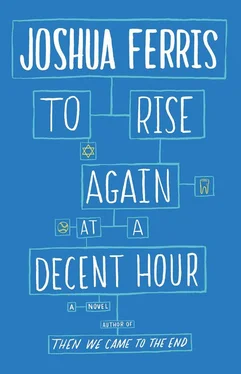“I don’t understand what your point is, Paul. Are you an anti-Semite, or aren’t you?”
“The point is you’re not curious! You’re not showing any concern! What if I am an anti-Semite?”
“But you’ve said that you’re not.”
“Can you prove it?”
“I’m going to finish the sterilizing now,” she said. “If you wish to tell me that you’re an anti-Semite, I’ll be right here.”
“Prove I’m not!” I cried. “Have a look online and prove it!”
She left the room. That was all she and I said on the subject.
My last patient of the day was a marketing executive with three cavities in need of filling. I conveyed that information to him and then was called away momentarily. When I returned, the marketing executive said, “I don’t think I’m going to have them filled.”
His X-rays were still on-screen. He could see his cavities as well as anyone. I looked again at his chart. He was well insured. There was no financial reason not to have his cavities filled. And I took it on faith that oral upkeep was at least of some concern to him. Otherwise, he would not have made the appointment.
“Okay,” I said. “But I do strongly recommend having those cavities filled at some point. They’re just going to get worse over time.”
He nodded.
I said, “Is it the pain you’re worried about?”
He looked puzzled. “It’s not painful to have a cavity filled, is it?”
“No,” I said, “that’s why I ask. It’s not painful at all. We numb you.”
“That’s what I thought,” he said. “No, it’s not the pain.”
“So just out of curiosity,” I said, “if it’s not the pain, why not have them filled? They’re just going to get worse over time, and then you really will be in pain.”
“Because I feel fine right now,” he said. “I don’t feel like I have any cavities.”
“But you do have cavities,” I said. “I just showed you where your cavities are. Look, they’re right here.”
I started to show him a second time.
“You don’t have to show me again,” he said. “I saw them the first time. I believe you.”
“So if you believe me, and you see there’s a problem, why not get it fixed? You have three cavities.”
“Because I don’t feel like I have them.”
“You don’t feel like you have them?”
“I don’t feel like I have them,” he said.
I was growing a little frustrated.
“Okay,” I said, “but indulge me for a moment. Look here, at the screen. Do you see the areas in shadow? One, two, three. Three cavities.”
“According to your X-rays,” he said. “And that’s fine. But I’m just telling you how I feel.”
“How you feel?”
“Right now I just don’t feel like I have any cavities. I feel fine.”
“But cavities aren’t something you always feel. That’s why we take the X-rays. To show you what you can’t feel.”
“That might be your way,” he said, “and that’s fine, but it’s not my way.”
“Not your way?” I said. “They’re X-rays. They’re everyone’s way. They’re science’s way.”
“And that’s fine,” he said. “But my way is how I feel, and right now I feel fine.”
“Then why did you come in? If you feel so fine and you don’t care what the X-rays say, why come in?”
“Because,” he said, “you’re supposed to. Every six months, you’re supposed to see the dentist.”
“Dr. O’Rourke?”
Connie was standing in the doorway.
“Will you excuse me?” I asked the marketing executive.
I went straight over, never happier to see her. “That guy in there,” I whispered, “won’t take my advice and get his cavities filled, because he says he doesn’t feel like he has any. He says he feels fine, so why should he have them filled? I’m showing him his cavities on-screen, and he tells me that’s just my ‘way.’ X-rays are my ‘way,’ he says. Science is my ‘way.’ His way is to feel around with his tongue and everything feels fine so just ignore the X-rays and the expert opinion. And when I ask him why he came in if he feels so fine, he tells me it’s because he’s supposed to! Every six months, you’re supposed to see your dentist! Is this really how people think? Is this really how they get along? Is it that easy?”
“My uncle Stuart’s here to see you,” she said.
I was quiet. “Again?”
The waiting room was empty with the exception of Stuart and an Asian woman sitting next to him, sunglasses perched on her head. They stood, the sunglasses came down, and Stuart introduced her. Her name was Wendy Chu, and she worked for Pete Mercer.
“You know Pete Mercer?” I said to Stuart.
“Not me personally,” he said. “I only know Wendy.”
Wendy was so petite and youthful looking behind the sunglasses that she might have been struggling for straight As in the seventh grade. She handed me a business card. Reading it, I was reminded of what Mercer had said in passing about having hired a private detective. The card read “Chu Investigations.” I looked back at her. We’ve come a long way, baby, from fedoras and frosted-glass doors.
“And how do you know Wendy?” I asked Stuart.
Wendy answered for him. “Funny things happen when two people go looking for the same woman.”
“What woman?”
“Paul,” said Stuart, “we’re here to ask you a favor. Would you accompany us into Brooklyn when you’re finished for the night?”
“What for?”
“There’s someone Mercer would like you to meet,” said Wendy.
“Where is Mercer?” I asked.
“He’s no longer involved,” she said.
“Involved in what?”
She looked at me blankly behind her sunglasses.
“I still have a patient,” I said.
“We can wait,” she said, sitting down.
“What’s going on?” I asked Stuart.
“As a personal favor,” he said, “come with us to Brooklyn.”
I returned to my marketing executive, who was sitting in the chair, patiently waiting. I sat down chairside and gave him a long look before throwing up my hands. “What are you still doing here?”
He was perplexed. “You told me to wait,” he said.
“But why listen to me?”
“Because you’re my dentist.”
“So you’ll wait when I tell you to wait, but when I tell you to have your cavities filled, you refuse?”
“I told you, I don’t feel like I have cavities.”
“But you do!” I cried. “You do have cavities!”
“According to the X-rays.”
“Yes, precisely! According to the X-rays!”
“But not according to how I feel,” he said.
We took Wendy’s car into Brooklyn, to the Jewish neighborhood of Crown Heights. Hebrew dominated the storefronts and awnings. Identically dressed women walked the streets pushing prams (not strollers but those upright pram things with big metal wheels), men in black hats, black suits, and black beards stepped into and out of minivans while talking on cell phones, and innumerable children of all ages defied the austerity of their sidelocks and somber dress to play as children will on the stoops and street corners. The sun was setting and the streets were orderly. With the exception of the tinted windows passing by shuddering with bass, we might have been back in the seventeenth century.
On the way over, I learned that I would be meeting with Mirav Mendelsohn, the woman with whom Grant Arthur had once been in love. I didn’t understand why. I told Stuart that I already knew all about her. Mirav had been born into an Orthodox Jewish family in Los Angeles before she fell in love with Arthur. When her family found out she was seeing a Gentile, they expelled her from the community. They eventually sat shiva for her as though she were dead. Over time, Arthur made one discovery, and then another, and another and another about his ancestry, and about who he really was. He felt duty-bound to leave Mirav and the life they had made together in Los Angeles, to devote himself to the arduous task of re-establishing a community of diasporic Ulms.
Читать дальше












